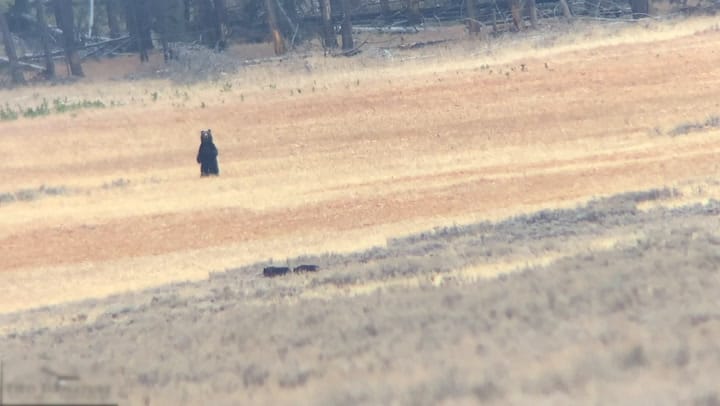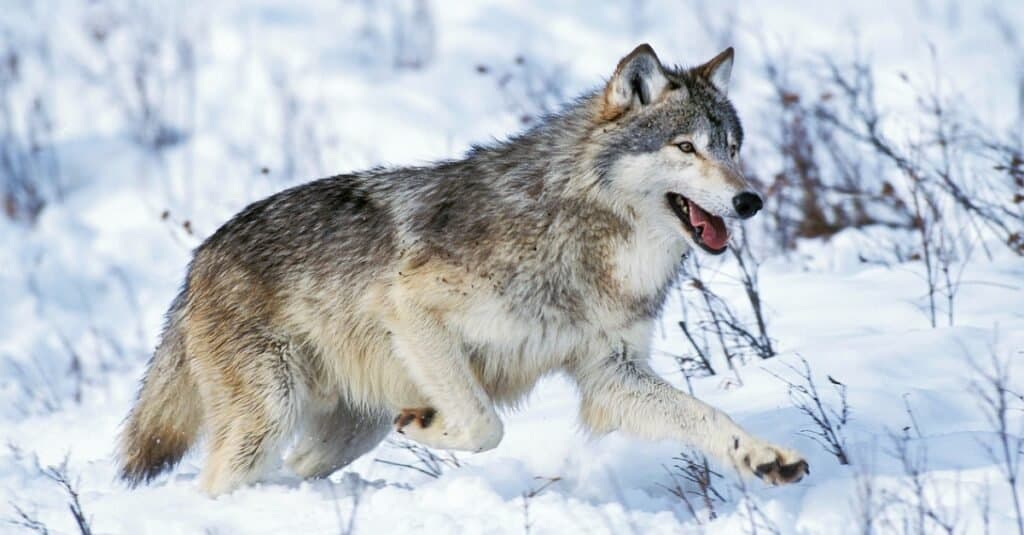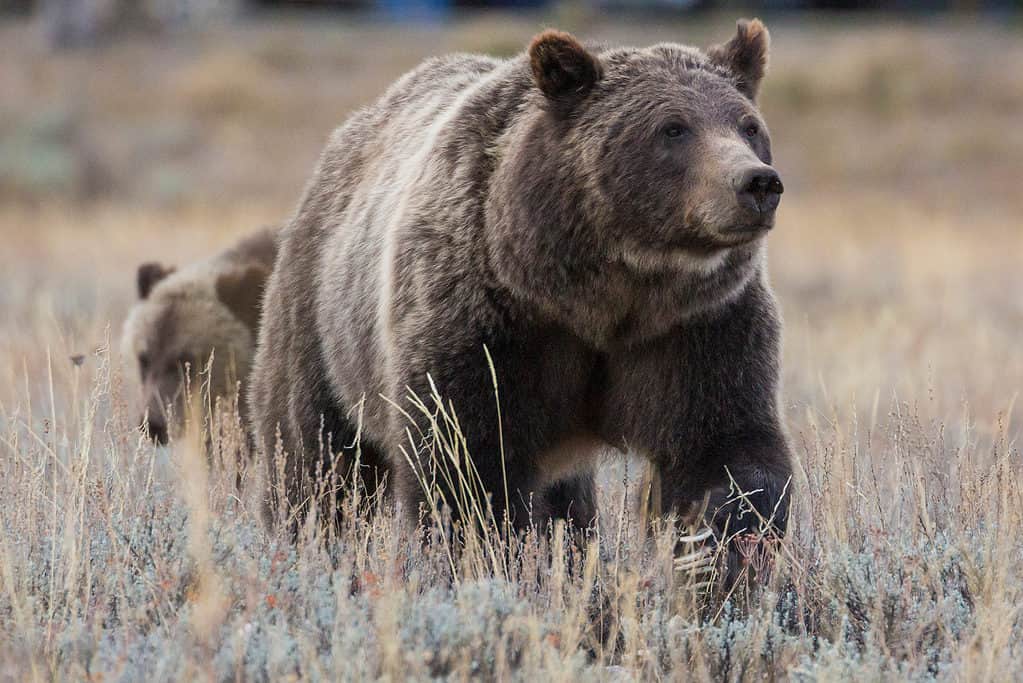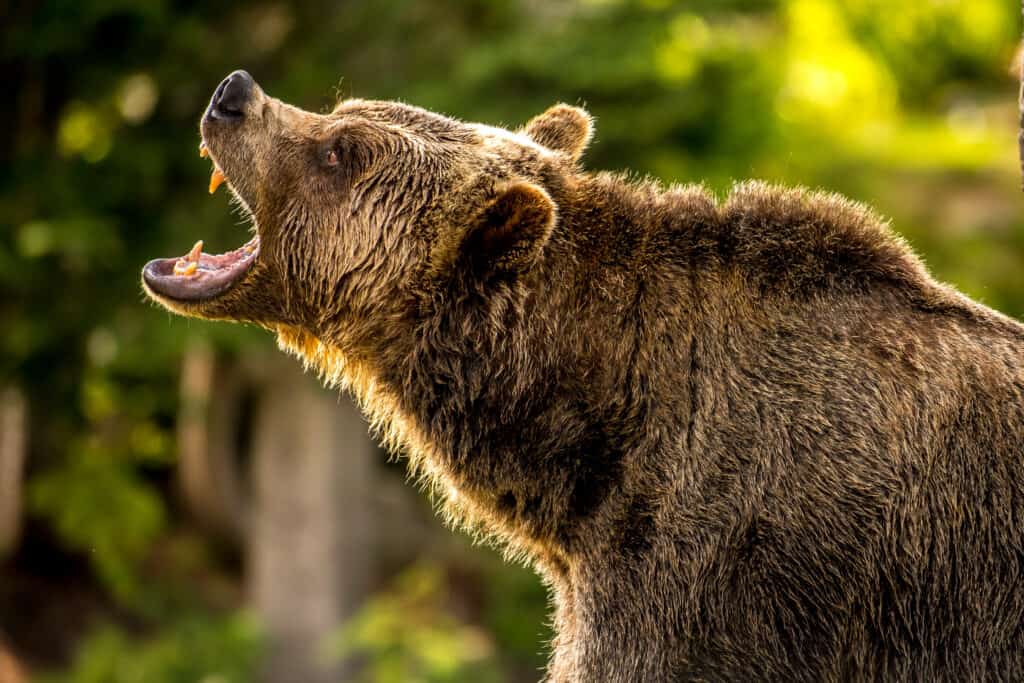Continue reading for our analysis...

What starts out as a low-key encounter between two predators just checking each other out evolves into something a bit more aggressive. The grizzly bear in this clip has clearly detected that the wolves are around and stands up on its hind legs to get a better look. Meanwhile, the wolves have decided that they would prefer it if the bear was not there. So, they encircle it and cause it a lot of problems until it moves away.
What Do Grey Wolves Usually Eat?

Gray wolves eat a lot of their prey and will usually eat the organs first.
©iStock.com/slowmotiongli
Grey wolves are carnivores and have to hunt other animals to survive. Their preference is for large hoofed animals so they target deer, bison, elk, and moose. They are big eaters and can consume 20 pounds of meat in one meal. However, smaller animals such as rodents, hares, and beavers can also be targets. They are pack animals who hunt, eat, and live together in groups.
Wolves eat much of their kill. When it comes to consuming their prey, organ meat takes priority. In most instances, all significant muscle portions are devoured, with ribs being a typical inclusion. Bones are often partially consumed.
Surprisingly, even the muscles forming the stomach lining are consumed. Finally, the red wolf is also known for eating such things as insects and even berries.
What Do Grizzly Bears Usually Eat?

Grizzly bears are omnivores and therefore eat plants and other animals.
©BlueBarronPhoto/Shutterstock.com
Grizzly bears are a type of brown bear although their colors can vary from very light tan to dark brown. There is some cross-over between the prey of grizzly bears and wolves. The bears are omnivores and therefore eat both plants and other animals. When it comes to plants, their diet includes fleshy roots, fruits, berries, grasses, and forbs (flowering plants).
Similar to wolves, their target prey includes moose and elk as well as caribou and deer. Bears would rather hunt the young of these species than the adults. They will also target smaller mammals like squirrels and some are very good at catching salmon.
How Large Are Grizzly Bears?

Grizzlies are substantial beings, capable of reaching weights exceeding 700 pounds.
©toseeg/Shutterstock.com
Grizzly bears are large creatures that could tip the scales at over 700 pounds (315 kilograms). Males, however, are generally heavier than females and can weigh between 400 and 600 pounds (200 to 300 kilograms).
The largest grizzly bear ever recorded weighed an impressive 1,200 pounds, a world record attained based on the size of its skull since it was not found alive. Unearthed by a taxidermist in 1976, this remarkable discovery still stands as the record-holder. The second-largest grizzly, taken down by a hunter in 2014, remains a notable runner-up.
Further, in the lower 48 States, sizable female grizzlies weigh around 250 to 350 pounds (110 to 160 kilograms).
Grizzly Bear and Wolf Interactions

Interactions between wolves and grizzlies are influenced by prey availability, hunger, and aggressiveness.
©Mircea Costina/Shutterstock.com
Interactions between bears and wolves have been researched by the National Park Service. These two species have historically co-existed and they usually avoid each other. However, there can be confrontations if certain circumstances exist.
The likelihood of a confrontation depends on a number of factors including the age, sex, and reproductive status of the animals involved. Interactions are also influenced by prey availability, hunger, and aggressiveness. The number of animals of each species involved is important — here the bear is clearly outnumbered. Also, animals learn from experience so previous experiences of interactions with the other species can have an effect.
Overall, it is very rare for bears to kill wolves or vice versa. The few reports of wolves killing bears have involved young, old, or otherwise weakened bears. This one looks as if it got away!
Is it Normal Behavior for Grizzly Bears to Take on a Pack of Wolves?

Sometimes bears and wolves cross territories or bears will follow wolves to a food source.
©Jim Cumming/Shutterstock.com
Despite their smaller size, wolves can pose a threat to bears because they travel in packs, outnumbering the bears. A grizzly bear may avoid confronting a single wolf or proceed with caution in such encounters.
A pack of wolves could potentially challenge a bear, but it would be a dangerous and challenging fight for the wolves. Wolves are formidable predators, highly social, and hunt in packs.
However, bears are also powerful and agile animals with sharp claws and strong jaws. While it’s rare for a fight to break out between animals, in areas where grizzlies and wolves coexist, it’s been observed that bears frequently trail wolf packs. This behavior is typically observed as anticipating that the wolves will guide them to a food source.
Furthermore, grizzlies take over carcasses from wolves by using their size to intimidate them.
How Big Do Grizzly Bears Get?

Male grizzly bears are heavier than the females of the species.
©BlueBarronPhoto/Shutterstock.com
Grizzly bears can weigh upward of 700 pounds although the average weight of a grizzly is generally a bit less. The males are heavier than the females and can weigh about 400 to 600 pounds, while a large female can weigh about 250 to 350 pounds. When standing up, they can reach heights of almost 9 feet tall, and when they are standing on all fours they are typically 3 to 5 feet at the shoulder. The largest grizzly bear ever caught in the world was an astonishing 1,200 pounds.
Thank you for reading! Have some feedback for us? Contact the AZ Animals editorial team.






